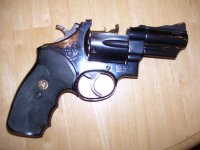Jake Benson
Member
- Joined
- Aug 18, 2011
- Messages
- 39
- Reaction score
- 4
I have a new 686. Last week I put about 100 rounds through it and got home to clean it and the cylinder would not close. Several posts said it the extractor rod was loose. I never felt it loose but kept messing with it and the cylinder closed.
Today I went to the range and after 6 rounds the cylinder jammed. The trigger would not pull. I dumped the bullets out and put them back in and it fired a couple of times and jammed again. The trigger would not pull. I thought maybe it was the bullets, (they were hand loaded ones I bought from a range the week before out of state), so I bought a commercial box from the range I was shooting at. But the gun jammed again. Each time after the cylinder locked up, I would take the rounds out and it would shoot. Finally, I put about 25 rounds through it without mishap and then it started misfiring. I pulled the trigger, the hammer came home, but nothing happened. Pulled the trigger again and it fired. The next pull same thing, no shot. I kept pulling the trigger and it got back around to the misfired rounds and they fired the second time. This happened 3-4 times. Finally, the last 25-30 rounds I shot fired without mishap.
Something is wrong here. Maybe the cylinder is out of sync or something. Anyone have any ideas? I hate having to send the gun back to Smith and Wesson if it could be easily fixed. I have a gunsmith I could take it to, but I hate spending money since its under warranty.
Today I went to the range and after 6 rounds the cylinder jammed. The trigger would not pull. I dumped the bullets out and put them back in and it fired a couple of times and jammed again. The trigger would not pull. I thought maybe it was the bullets, (they were hand loaded ones I bought from a range the week before out of state), so I bought a commercial box from the range I was shooting at. But the gun jammed again. Each time after the cylinder locked up, I would take the rounds out and it would shoot. Finally, I put about 25 rounds through it without mishap and then it started misfiring. I pulled the trigger, the hammer came home, but nothing happened. Pulled the trigger again and it fired. The next pull same thing, no shot. I kept pulling the trigger and it got back around to the misfired rounds and they fired the second time. This happened 3-4 times. Finally, the last 25-30 rounds I shot fired without mishap.
Something is wrong here. Maybe the cylinder is out of sync or something. Anyone have any ideas? I hate having to send the gun back to Smith and Wesson if it could be easily fixed. I have a gunsmith I could take it to, but I hate spending money since its under warranty.


